Table of Contents
- Why Preschool Classroom Ideas Matter for Learning Success
- Essential Learning Centers Every Classroom Needs
- Strategic Layout Planning for Optimal Function
- Age-Specific Preschool Classroom Ideas
- Managing Challenging Classroom Situations
- Natural Materials and Wooden Educational Tools
- Seasonal Updates and Theme Integration
- Budget-Conscious Enhancement Strategies
- Safety and Accessibility Standards
- Measuring Success in Your Learning Environment
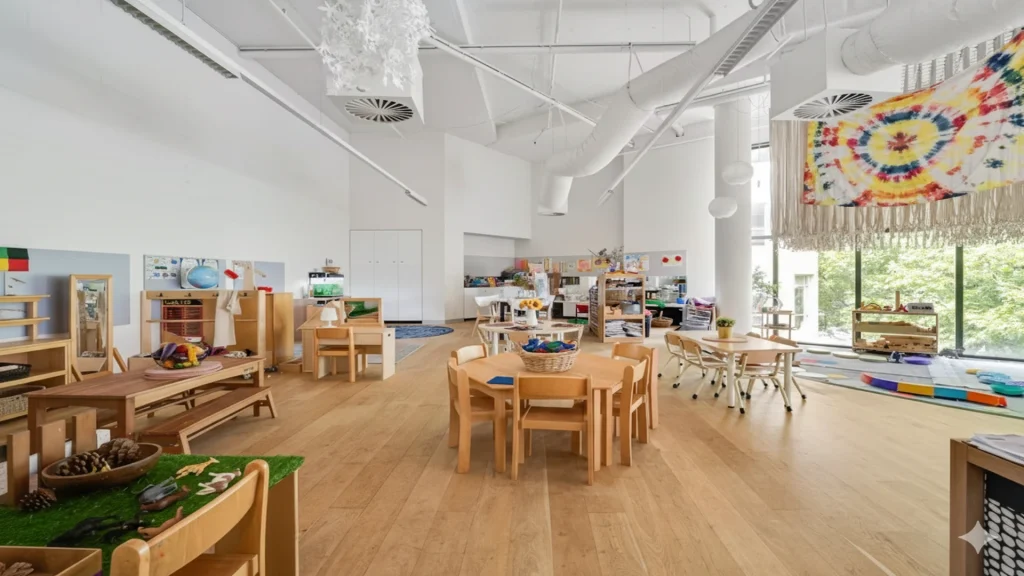
Preschool classroom ideas form the foundation of effective early childhood education. Research from the National Association for the Education of Young Children (NAEYC) demonstrates that thoughtfully designed learning spaces directly influence children’s cognitive development, social skills, and educational outcomes.
This comprehensive guide explores evidence-based preschool classroom ideas that transform ordinary spaces into dynamic learning environments where young minds thrive.
Why Preschool Classroom Ideas Matter for Learning Success
The physical environment serves as a powerful teaching tool in early childhood education. When implementing effective preschool classroom ideas, educators create spaces that:
- Enhance cognitive development through strategic learning zones
- Promote independence with accessible, child-sized furniture
- Support emotional regulation through calm spaces
- Encourage social interaction via collaborative learning areas
- Stimulate creativity using natural materials and open-ended resources
Successful preschool classroom ideas go beyond aesthetics. They create functional zones that support different types of learning while maintaining safety and accessibility for all children.
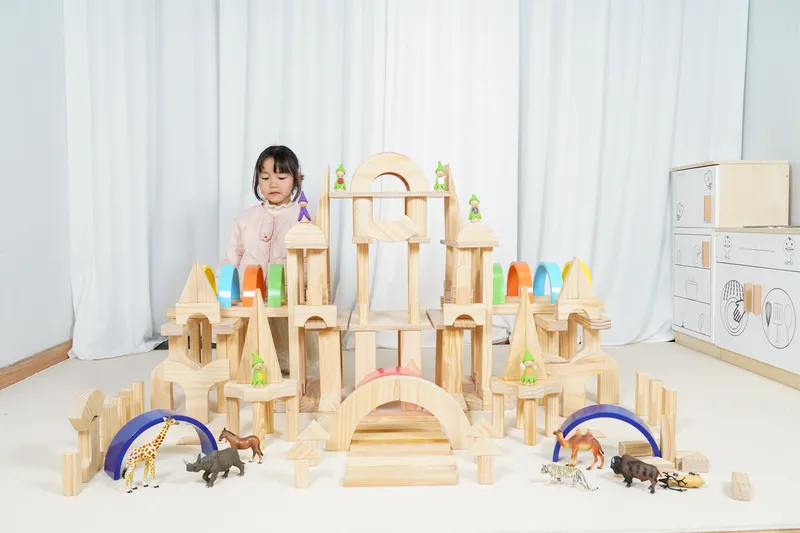
Essential Learning Centers Every Classroom Needs
Block and Construction Zone
The block center consistently ranks as one of the most valuable areas when developing preschool classroom ideas. This space supports mathematical thinking, spatial reasoning, and problem-solving skills through hands-on construction play.
Key Design Elements:
- Various sized wooden unit blocks for different skill levels
- Foam flooring to minimize noise and provide safety
- Open shelving systems with clear organization
- Adequate floor space for collaborative building
Position the block center away from quiet areas but where supervision remains easy during small group activities.
Dramatic Play Area
Transform this space regularly to maintain high engagement and support curriculum connections. Popular preschool classroom ideas for dramatic play include:
- Medical clinic with child-sized equipment
- Grocery store with realistic props and wooden cash register
- Restaurant or bakery with play food and cooking utensils
- Post office or library for literacy connections
The key is providing authentic props that spark imagination while supporting learning objectives.
Science and Discovery Center
Young children are natural scientists who thrive on exploration. Create engaging discovery experiences that change regularly to maintain curiosity.
Essential Components:
- Magnifying glasses and collection containers
- Sensory tables with rotating materials (rice, water beads, sand)
- Simple experiment stations with safe materials
- Wooden science exploration tools designed for small hands
Art Studio Area
Art centers should accommodate various types of creative expression while being manageable for both children and teachers.
Setup Strategies:
- Easels positioned for easy supervision and cleanup
- Storage systems that encourage independence
- Variety of materials accessible at child height
- Display areas that celebrate children’s creative work
Literacy and Language Center
Support emerging literacy skills through comfortable, inviting spaces that encourage interaction with books and writing materials.
Design Features:
- Cozy reading nooks with soft seating options
- Book displays that showcase covers rather than spines
- Wooden letter manipulation tools for hands-on learning
- Interactive word walls and alphabet displays
Strategic Layout Planning for Optimal Function
Managing Noise Levels
Effective preschool classroom ideas include careful zoning to prevent louder activities from disrupting quieter learning experiences. Position blocks, dramatic play, and music areas together while keeping reading, writing, and puzzle areas in calmer zones.
Creating Clear Pathways
Avoid “racetrack” layouts where children can run in continuous circles. Use furniture placement to create defined pathways and natural boundaries between different areas.
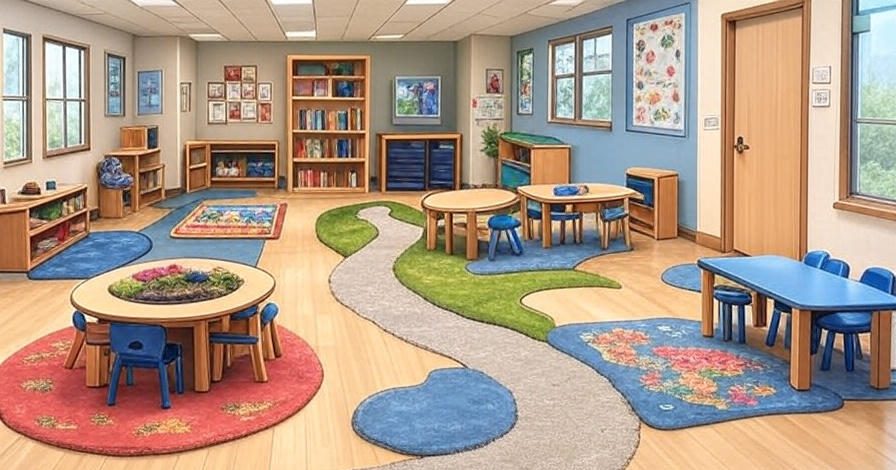
Supervision Considerations
Design your layout so you can visually monitor all areas while working with small groups. Position the small group table to face the room’s activity areas or use low shelving that doesn’t block sight lines.
Flexibility for Different Group Sizes
Choose furniture that can be easily reconfigured for various activities. Lightweight tables and modular wooden storage units allow for quick adjustments throughout the day.
Age-Specific Preschool Classroom Ideas
Toddlers (18 months – 3 years)
Focus on safety, sensory exploration, and parallel play opportunities. These children need:
- Lower furniture and materials within easy reach
- Duplicates of popular toys to reduce conflicts
- Soft areas for comfort and emotional regulation
- Simple cause-and-effect materials and toys
Preschoolers (3-4 years)
Expand complexity while maintaining accessibility. Important preschool classroom ideas include:
- More sophisticated dramatic play props
- Beginning academic materials like puzzles and matching games
- Opportunities for collaborative play and projects
- Wooden educational toys that challenge without frustrating
Pre-Kindergarten (4-5 years)
Prepare children for more structured learning while maintaining play-based approaches:
- Complex building materials and engineering challenges
- Early literacy and numeracy materials
- Research and investigation opportunities
- Spaces for presenting and sharing work with peers
Managing Challenging Classroom Situations
Supporting Solo Teachers
Many preschool teachers face the challenge of managing classrooms independently. Effective preschool classroom ideas that support this reality include:
For Diaper Changes and Bathroom Assistance:
- Position changing areas with clear sight lines to the classroom
- Create high-interest activities that can occupy children independently
- Use visual schedules and routine cards to support predictable transitions
- Wooden activity boxes that can be easily accessed without adult assistance
Managing Transitions:
- Clear visual cues for different activities and expectations
- Song and movement activities that redirect energy positively
- Calm-down spaces equipped with sensory tools and comfort items
Creating Inclusive Environments
Design spaces that accommodate children with diverse needs:
- Multiple types of seating options (chairs, floor cushions, standing options)
- Clear visual supports and labeling systems
- Quiet retreat spaces for sensory breaks
- Accessible storage and materials at various heights
Natural Materials and Wooden Educational Tools
Research published in the International Journal of Early Childhood demonstrates that natural materials reduce stress and promote deeper engagement. Consider these preschool classroom ideas incorporating natural elements:
Wooden Materials:
- Natural wood building blocks in various shapes and sizes
- Tree cookies for counting, sorting, and building
- Wooden tools for sand and water play
- Natural fiber baskets for storage and organization
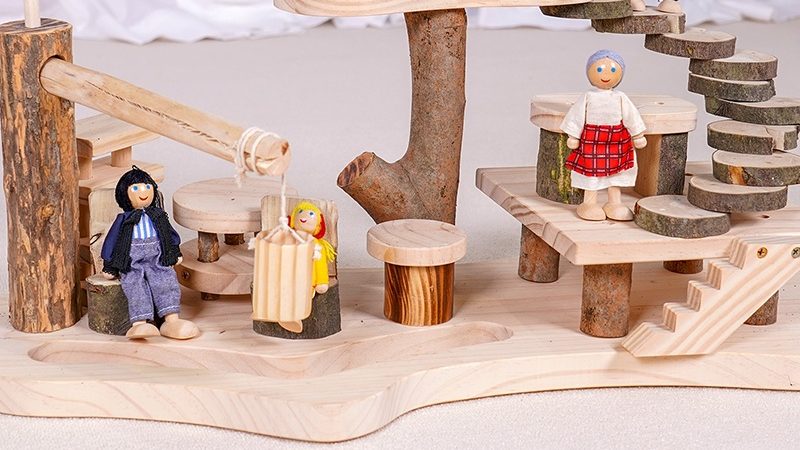
Living Elements:
- Classroom plants that children can care for and observe
- Natural light whenever possible
- Views of outdoor spaces or nature scenes
Seasonal Updates and Theme Integration
Keep your classroom environment dynamic while avoiding overwhelming changes through these preschool classroom ideas:
Popular Classroom Themes
Space Exploration:
- Transform dramatic play into a space station
- Add constellation displays and planet models
- Include space-themed books and building challenges
Ocean Adventures:
- Create underwater dramatic play environments
- Add shell and sea glass collections for sorting
- Include wooden role-play sets for authentic experiences
Seasonal Refresh Strategies
Rather than completely redesigning your classroom, make strategic updates:
- Change bulletin board displays and wall decorations
- Rotate books and materials to reflect seasonal interests
- Add seasonal elements to sensory tables and discovery areas
- Update dramatic play props and themes
Budget-Conscious Enhancement Strategies
Creating engaging environments doesn’t require unlimited resources. Smart preschool classroom ideas include:
DIY Solutions
- Repurpose household items for dramatic play props
- Create sensory bins using clear storage containers
- Make interactive displays with laminated materials and Velcro
- Design custom organization systems using recyclable materials
Strategic Investments
- Focus on high-quality, durable pieces that serve multiple purposes
- Wooden furniture and toys that last for years
- Versatile materials that can be used across multiple centers
- Storage solutions that grow with changing needs
Community Partnerships
- Partner with local businesses for material donations
- Organize parent work days for classroom improvements
- Connect with community resources for specialized materials
- Collaborate with other classrooms for resource sharing
Safety and Accessibility Standards
All preschool classroom ideas must prioritize child safety:
Furniture Safety
- Age-appropriate sizing and weight
- Rounded edges and non-toxic finishes
- Secure anchoring of tall furniture to walls
- Regular inspection and maintenance schedules
Material Safety
- Non-toxic art supplies and cleaning materials
- Age-appropriate materials that eliminate choking hazards
- Proper storage of small items and potential hazards
- Clear sight lines for effective supervision
Accessibility Features
- Multiple ways to access and engage with materials
- Varied seating options for different physical needs
- Clear pathways for mobility equipment if needed
- Visual supports and communication aids
Measuring Success in Your Learning Environment
Track the effectiveness of your preschool classroom ideas through systematic observation:
Engagement Indicators
- Time children spend in different centers
- Quality of interactions and play behaviors
- Independence in accessing and using materials
- Collaborative play and social interaction patterns
Learning Outcomes
- Progress in developmental milestones
- Growth in specific skill areas
- Emotional regulation and self-control development
- Problem-solving and creative thinking demonstrations
Teacher Effectiveness
- Ease of supervision and classroom management
- Efficiency of cleanup and transitions
- Flexibility for different group sizes and activities
- Support for diverse learning styles and needs
Building Parent and Community Connections
Involve families in the classroom environment to strengthen home-school connections through these preschool classroom ideas:
Family Engagement Strategies
- Photo displays of children’s learning experiences
- Family picture galleries and cultural celebrations
- Parent volunteer opportunities for classroom enhancement
- Home-school connection materials and resources
Communication Systems
- Visual documentation of learning activities
- Regular updates about classroom changes and themes
- Opportunities for family input on classroom design
- Celebrations of children’s achievements and growth
Professional Development for Effective Environment Design
Stay current with best practices through ongoing learning:
- Early childhood environment design workshops
- Observation visits to exemplary programs
- Professional learning communities with other educators
- Research updates on child development and learning environments
The Reggio Emilia approach offers valuable insights into creating environments that serve as the “third teacher” in early childhood education.
Conclusion: Creating Spaces Where Every Child Thrives
Effective preschool classroom ideas combine research-based practices with practical implementation strategies. By thoughtfully planning learning centers, managing challenging situations, and maintaining focus on child development, educators create environments that truly support every aspect of early learning.
The investment in quality classroom design—from choosing appropriate materials to creating flexible learning zones—directly impacts children’s educational experiences and developmental outcomes. Success comes from understanding that the physical environment is a powerful teaching tool that can either support or hinder learning goals.
Remember that the most effective preschool classroom ideas evolve based on observation of children’s needs, interests, and responses. Start with these foundational principles and adapt them to create the unique learning environment that best serves your specific group of children and families.
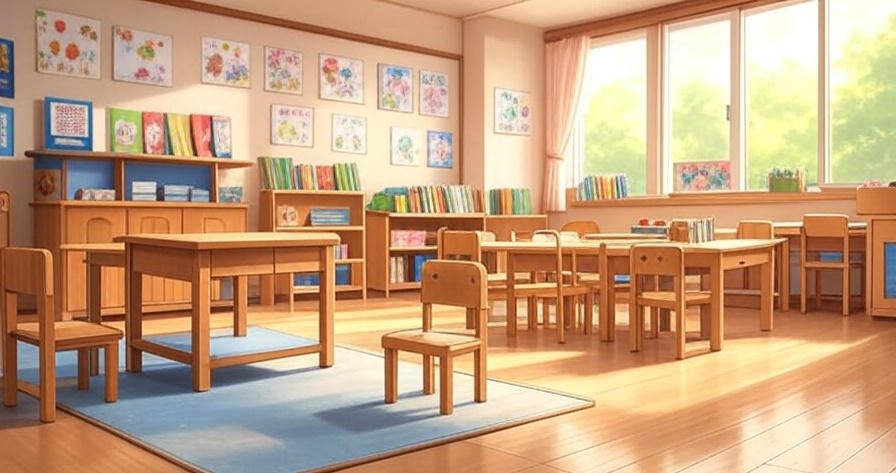
Ready to transform your preschool classroom with high-quality wooden educational materials? Explore our comprehensive collection of sustainably crafted furniture and learning tools designed specifically for early childhood environments.